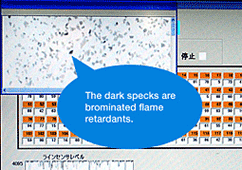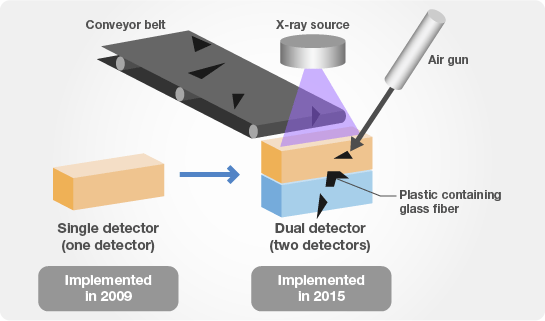Plastic recycling comes of age
Green Cycle Systems: Refining Old Plastics into Industrial-Grade Materials
Japan's First Large-Scale, High-Purity Plastics Recycling Company

Green Cycle Systems Corporation
Green Cycle Systems Corporation commenced operation in April 2010, processing a granulated plastics mixture received from Hyper Cycle Systems Corporation into plastic materials pure enough to meet the safety and quality standards required for new electrical appliances.
This company is the fruition of more than a decade of efforts by Mitsubishi Electric to create a new, sustainable recycling industry from scratch. Applying automated processes, it optimizes the recovery of reusable raw materials from the granulated plastics mixture at a rate of 12,000t out of 15,000t per year. Together with Hyper Cycle Systems, the combined output amounts to a high-purity plastic materials recycling ratio of 80%.

Innovative Plastic Separation Technology
The mix of shredded plastic chips Green Cycle Systems receives from Hyper Cycle Systems primarily consists of the three main types of plastic used in home appliances: polypropylene (PP), polystyrene (PS) and acrylonitrile-butadiene-styrene (ABS). By using automated plastic separation equipment developed by Mitsubishi Electric, these are precisely extracted and processed on a large scale, and at purity levels exceeding 99%.
This high degree of purity is made possible by proprietary technologies for separating different plastics by specific gravity and by electrostatic properties, and by separating plastics containing banned substances using computer-controlled x-ray detection devices mapped to multiple air jets capable of pinpoint accuracy.
Recovering high-purity PP, PS and ABS is an enormous challenge, and from the beginning there were no road maps to follow. Numerous specialists at Hyper Cycle Systems and Mitsubishi Electric's R&D and technology centers, as well as manufacturing operations throughout Japan, were assembled to create the automated machinery and innovative processes required for a new, sustainable recycling industry. Their breakthroughs in technology eliminated each stumbling block one by one.
The first innovation was a wet specific gravity separator for PP, or polypropylene. PP is light compared to PS and ABS, which are roughly equivalent in size and weight. PP is also lighter than water, so it floats. Applying water processing, or wet specific gravity separation equipment, PP rises to the water's surface, where it is easily recovered.
ABS and PS, which are heavier than water, cannot be isolated in this way, so the next innovation was technology that exploits their different electrostatic properties. When PS and ABS are subjected to agitation, the resulting friction generates static electricity. PS responds to a negative charge and ABS a positive charge. Therefore, applying a voltage to positive and negative electrodes is an efficient way to channel the two plastics away from each other.

New Technologies Applying X-Rays and Mid-Infrared Light to Further Promote the Recycling of Plastics
1 X-Ray Technology for Removing Plastics Containing Foreign Matter
In order to increase efficiency in plastics recycling processes, it is important to remove foreign matter to produce plastics with the highest possible purity. Mitsubishi Electric is evolving plastics recycling through the introduction of new technologies that utilize X-rays.
One such technology developed in 2009 is capable of detecting granulated plastics containing brominated flame retardants—banned by RoHS—at high speed and then removing them. Recycling plants receive household electrical appliances that have been used for varying lengths of time and the plastic used in old products may contain brominated flame retardants. Mitsubishi Electric developed a device that utilizes X-ray images to instantly detect plastics chips containing brominated flame retardants and then air guns are used to separate them from the lot (X-ray sorting equipment). This technology received the Minister of the Environment Award (the highest award) of The 37th Environment Awards in 2010.
-

X-ray sorting equipment for removing plastics containing bromine
-

Award-winning technology where X-rays detect chips containing flame retardant in the granulated plastics mixture, and 124 individual air guns are instantly instructed to blow them aside.
Another technology is one that removes plastic chips containing glass fiber, a feat which was believed to be impossible up until now. Glass fiber is used to increase the strength of plastic; however, plastics containing glass fiber cannot be recycled. To address this issue, Mitsubishi Electric made a breakthrough by installing two detectors rather than one. Plastics that have been finely crushed have varying thicknesses, and this results in various X-ray transmittance ratios. For example, if plastic chips are thin, it may appear that they do not to contain glass fiber even if they do. On the other hand, if plastic chips are thick, they may appear to contain glass fiber even if they do not, which leads to misdetection. The utilization of two detectors with different x-ray sensitivities makes it possible to cancel out the impact of varying thicknesses. This new technology was introduced for mass production purposes in June 2015.

Fiber-reinforced plastic
Foreign Matter Detection System


2 Technology Utilizing Infrared Light with 99% Accuracy in Identifying Plastic Types (2012)
The Mitsubishi Electric Group announced details of a newly developed high-purity plastic recycling identification technology in February 2013. With this technology, it is now possible to prescreen plastics and to conduct purity control inspections after removing pieces of plastic that contain restricted-use materials. Plastics contain coloring agents and additives that hinder rigorous screening. Using a high-purity plastic identification device, infrared light is reflected off shards in the granulated plastic mixture. By analyzing these reflections, various types of plastic can be identified with an accuracy of 99% irrespective of pigmentation or additives. It only takes a very short time of approximately one second to identify the type of plastic. In utilizing this technology, it is possible to prescreen the ratio of various types of plastic that should be processed at plants, thereby improving recycling efficiency.
Illustration of High-Precision Plastic Identification System

Note
Development of this technology was a joint collaboration undertaken by Mitsubishi Electric and Shimadzu Corporation in fiscal 2011, and was funded by a grant from the Ministry of Economy, Trade and Industry (Japan) to support businesses that develop and commercialize industrial technologies (to be used to verify resource recycling systems and develop advanced plastics identification and recycling technologies).
Green Cycle Systems Corporation website
(Japanese only)